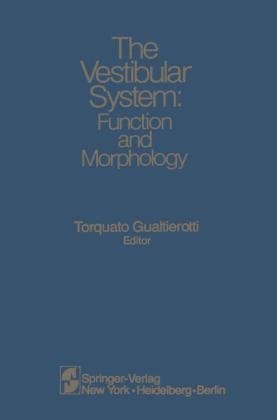
The Vestibular System
Springer-Verlag New York Inc.
978-0-387-90559-4 (ISBN)
- Titel ist leider vergriffen;
keine Neuauflage - Artikel merken
Fortunately, it was possible to secure the contributions of a number of outstanding investigators from both the United States and abroad, including functionally oriented morphologists. ultrastructuralists, biophysicists, and vestibular physiologists. The result is a comprehensive discussion of the main mechanisms of the labyrinth: the transduction pro- cess at the receptor level, in the semicircular canals, and in the utricular and saccular maculae; the information transfer through neuronal pathways to the nuclei and the cerebellum; and the general organization of the system.
1 Morphology.- 1. The Structure of the Vestibular Sensory Epithelia.- 2. The Afferent and Efferent Vestibular Pathways: Morphologic Aspects.- 3. Otolith Organ Receptor Morphology in Herring-like Fishes.- 4. Is the Growth of the Otolith Controlled by Its Weight?.- 5. Morphologic Observations of Human Otoconial Membranes.- 6. Vestibular Nuclei: Neuronal Loss in Mice with Otoconial Agenesis and Evidence of Right-Left Asymmetry.- 7. Central Projections to the Vestibular Nuclei From the Subparafascicular Region of the Rabbit.- 8. Vestibular Projections to the Monkey Thalamus and Rostral Mesencephalon: An Autoradiographic Study.- 9. Ionic Mechanisms in the Vestibular Apparatus: The Resting State.- 10. Centrally Originating Efferent Terminals on Hair Cells: Fact or Fancy?.- 2 Morphology and Function Interrelationship.- 11. Thick and Thin Mammalian Vestibular Axons: Afferent and Efferent Response Characteristics.- 12. Semicircular Canal Morphology and Function in Crabs.- 3 Vestibular Function.- 13. Functional Characteristics of Central Vestibular Neurons.- 14. The Influence of Duct and Utricular Morphology on Semicircular Canal Response.- 15. Mechanical Properties of Sensory Hairs in the Semicircular Canal Crista.- 16. A Species Comparison of Linear and Nonlinear Transfer Characteristics of Primary Afferents Innervating the Semicircular Canal.- 17. The Origin and Functional Significance of the Resting Activity and Peripheral Adaptation in the Vestibular System.- 18. Variability of the Spontaneous Firing Rate of Vestibular Receptors in a Stable, Controlled Bullfrog Preparation.- 19. The Comparative Sensitivity of Selected Receptor Systems.- 20. Horizontal Canal Afferent Dynamics Measured Using White Noise and Cross Spectral Analysis.- 21. Analysis of Horizontal Canal Afferent Dynamics Using White Noise and Sinusoids in the Barbiturate Anesthetized Cat.- 22. The Response of Primary Semicircular Canal Neurons to Angular Accelerations of Varying Magnitude.- 23. Dynamic Properties from Utricular Afferents.- 4 Visual-Vestibular Interactions.- 24. Visual and Vestibular Influences in Human Self-Motion Perception.- 25. Vestibular Neuron Response Alteration with Repeated Angular Acceleration.- 26. Responses of Neurons in the Vestibular Nuclei of Awake Squirrel Monkeys During Linear Acceleration.- 27. Visual Modulation of Otolith Responses: A Paradigm for the Study of Self-Motion Perception and its Neural Substrate.- 28. Cerebellectomy in Goldfish Prevents Adaptive Gain Control of the VOR without Affecting the Optokinetic System.- 29. Vestibular Nuclei Activity and Nystagmus in the Alert Monkey and Their Relation to Optokinetic and Vestibular Stimulation.- 30. The Influences of Head Orientation and Bilateral Semicircular Canal Plugs upon the Vertical Vestibuloocular Reflex of the Rabbit.- 31. Ewald's Second Law of Labyrinthine Function and the Vestibuloocular Reflex.- 32. A Model for Visual-Vestibular Interaction.
| Zusatzinfo | biography |
|---|---|
| Verlagsort | New York, NY |
| Sprache | englisch |
| Gewicht | 1105 g |
| Themenwelt | Sachbuch/Ratgeber ► Natur / Technik ► Natur / Ökologie |
| Sachbuch/Ratgeber ► Natur / Technik ► Naturführer | |
| Medizin / Pharmazie ► Medizinische Fachgebiete ► HNO-Heilkunde | |
| Studium ► 1. Studienabschnitt (Vorklinik) ► Physiologie | |
| Naturwissenschaften ► Biologie ► Humanbiologie | |
| ISBN-10 | 0-387-90559-6 / 0387905596 |
| ISBN-13 | 978-0-387-90559-4 / 9780387905594 |
| Zustand | Neuware |
| Haben Sie eine Frage zum Produkt? |
aus dem Bereich


